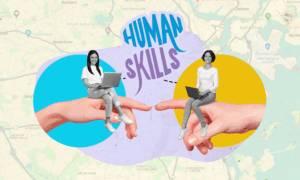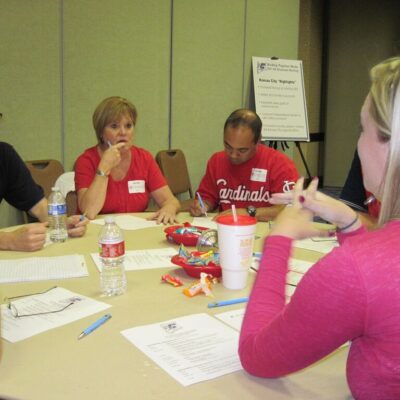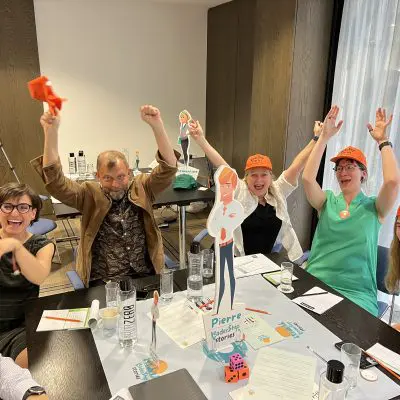Employee development is an essential part of creating a talented and dedicated workforce. According to Gallup, organizations that invest in developing employees are 11% more profitable and have double the retention rates of those who do not. On the other hand, bad managers and a lack of career development are the top reasons for turnover. Businesses need to ensure that managers support their employees and offer them opportunities to grow and develop their skills.
On our recent podcast—Teaching Power Skills in the Workplace—we talked with Laura Sukorokoff, Chief Engagement Officer of Take Charge Learning, about how leaders and managers can support their employees. She emphasized listening to employees, saying:
“By listening to your employees, by asking the right questions, and really doing some good listening, you’ll pick up on things. Is there a theme here? Is there a pattern? Are several members of your team struggling with certain skill sets or expectations?”
Today, let’s take a closer look at employee development, what it is, why it’s important, and strategies managers can use to encourage it in the workplace.
What is Employee Development?
First, let’s answer the question “what is employee development?” In simple terms, it is the process of improving employees’ current skills and learning new ones. That includes everything from soft skills like communication to hard skills like new sales techniques.
Employees want to grow. Being offered opportunities for growth makes them feel more valued and cared about, which in turn makes them better employees. It benefits both the employee and the business as a whole. Having an employee development plan can help you ensure that your employees get the growth they need, helping keep them satisfied while creating more skilled and well-rounded employees. However, you need to understand the three components of development before making a plan.
Skills Enhancement
The first component is skill enhancement. As the name suggests, this one is all about developing skills. This covers any sort of skills, whether they be soft skills or hard skills, that are necessary for their work. The importance of skill development is not to be understated. It helps your employees become more efficient, creative, and productive, while also creating a more fulfilling and engaging workplace that reduces turnover.
That said, skill enhancement is not the end all be all. It is but one component of developing employees, and the other components are equally as important.
Career Advancement

The next component is career advancement. This is the process of helping employees grow and advance in their careers. Though developing skills is a part of that, career advancement is more focused on the end result—advancing careers.
Many workplaces provide opportunities for developing skills but fail to provide meaningful work opportunities for career advancement. This is a recipe for turnover, as you’re preparing employees for higher-up roles without providing them an opportunity to take those roles.
A simple example of career advancement is offering new positions to employees or promoting internally. Help them develop the skills required for better positions, and then give them the chance to advance their career by taking on those positions.
Personal Growth
The most overlooked aspect of these three components is personal growth. This can be a bit of a broad term, covering all sorts of personal growth relating to the workplace. To be more specific, it includes things like finding new professional interests, learning more about yourself and your skills, setting and achieving goals (such as improving your public speaking), looking for growth opportunities, and more.
While there may be a lot of overlap with the over components, personal growth is all about helping employees grow as individuals, personally and professionally. As with skill and career advancement, personal growth benefits everyone. Employees get to grow and become better versions of themselves, which also helps businesses by improving the skills, productivity, and knowledge of employees.
Why is Employee Development Important?
You might still be asking, “why is employee development important?”, so let’s spend some time answering that question by looking at the benefits for employees and the organization.
Starting with the business side, the development of employees is closely related to retention. Employees want to feel valued, and they don’t want to feel trapped or stagnant. Developing your employees addresses both of those concerns to avoid turnover. When employees feel like their employer cares about them, wants to help them grow, and provides opportunities for career advancement, they are much more likely to stay with the company. Sukorokoff noted this during our conversation when she said:
“Although we may not be seeing the wave of quitting that we were before, what we are seeing is a lot of people are open to new opportunities. And they’re not afraid to go after those new opportunities.”
Another reason why professional development is important is that it creates better employees. It helps them hone current skills and gain new skills, making them more efficient, productive, and adaptable employees.
Shifting to the employee side of things, it’s also a great way to boost morale. Employees are happier and healthier in positive workplaces with high morale, which results in higher quality and more efficient work. Another benefit is that employees feel more fulfilled. Offering opportunities for growth and development helps them achieve their own goals. This again results in happier and healthier employees, which benefits the entire workplace.
How Can Managers Support Employees?
Managers play an important role in all this, and knowing how managers can support employees is key. The development of employees ultimately starts with management, so managers need to be equipped with the knowledge and skills to do so.
One of the simplest and most effective ways to support employees is simply talking to them, asking questions, and being a good listener. Sukorokoff emphasized this point and the need for managers to not be afraid, saying:
“Don’t be scared of it. Just jump in and ask the questions, and your questions need to be geared towards the people. So for example, how can I support you? What’s challenging you right now? Okay, what have you already tried? How can I support you? What do you need from me? So just put yourself in their shoes and what would you want to hear?”
Good communication skills lay the groundwork for connecting with and supporting employees, so don’t overlook the power and importance of good communication skills for management.
4 Employee Development Strategies
To wrap things up, let’s look at four employee development strategies you can use to successfully develop employees. Before starting though, it’s important to note this doesn’t have to mean spending lots of money. Sukorokoff highlighted this when she said:
“Professional development also comes from things like reading articles and watching videos. There are MOOCs—Massive Open Online Courses—that people can actually access university level education for free or very cheap.”
Point being—don’t let a tight budget stop you from developing your employees.
Providing Learning Opportunities
One simple and effective strategy is to provide learning opportunities. These can come in many shapes and sizes, focusing on all sorts of different skills through a variety of means. For example, there are team building activities such as Human Skills and Change Management that can provide great collective learning opportunities to employees.
But there are other cheaper options too, such as book clubs, mentorship programs, inviting experts from your network to speak, and more.
Creating an Employee Development Plan
Creating an employee development plan is another great strategy. Having a plan can ensure that you are doing what’s necessary to help employees grow and have something to follow along the way. There are three steps in creating a development plan: assessing your business goals, identifying individual employee goals, and creating individual development plans for employees that work to achieve both of those goals simultaneously.
On top of that, you’ll also want to create a timeline for achieving those goals. A timeline ensures that you’re making progress and the plan doesn’t fall by the wayside. There also needs to be a mechanism for feedback and evaluation, which leads to the next strategy.
Offering Feedback and Recognition
Feedback and recognition are a necessity for any sort of growth, and career growth is no exception. Offering constructive feedback on an employee’s efforts and recognition for their achievements can make a big difference.
Feedback helps employees see where they’ve succeeded and where there is room for improvement, ensuring that their growth continues. And recognition can provide a needed boost to help push them to keep going, as well as boosting their morale.
Supporting Career Development
Last but not least is supporting career development. This just means going out of your way to help employees, being there for them, and providing the resources they need to develop their careers.
There are lots of ways to go about this. An event like Leadership Stories can help cultivate better leadership skills, encouraging employees to grow and become leaders in their own right. You can also support career development internally by offering promotions, mentorship programs, job assignments, informational interviews, providing feedback, and more.
Support Employee Development with TeamBonding
Investing in career development is an integral part of driving business success. It helps employees grow, enhance their careers, and become better employees–and having better employees mean you’ll have a more productive, efficient, and talented workforce.
Employee development events are a great resource businesses can utilize to prioritize growth and development. At TeamBonding, we have years of experience facilitating events that help employees become the best they can be.
Support your employees by prioritizing their development. We have numerous events perfectly suited for employee development, so take a look and get in touch with us today.
















